
by John P. Pratt
13 Feb 2019, 1 Skull (SR), 1 Translation (Mars), 1 Birth (UM), Crown (US)
©2019 by John P. Pratt. All rights Reserved.
|
1. Accepted Chronology 1.1 Accepted Reigns 1.2 Anchor Needed 2. Errors Discovered 2.1 Dark Centuries 2.2 Ages in Chaos 2.3 Myth to History 2.4 Exodus as Anchor 3. Exodus Accounts 3.1 Ipuwer Papryus 3.2 Biblical Account 3.3 Jasher's Account 4. Proposed Anchors 4.1 Exodus Date 4.2 Fall of Jericho 4.3 Deluge Date 5. Conclusion Notes |
The chronology of Ancient Egypt has been worked on by scholars for centuries. It is no longer based merely on the traditional king list of Manetho, an Egyptian of the third century BC.[1] Several other sources have been found, mostly verifying the ancient pharaohs on his list[2] but resulting in the lengths of the reigns of many of the pharaohs having been substantially shortened.[3]
 |
There is one Egyptian papyrus which describes a catastrophe which occurred at some time in Egyptian history which has been difficult to pinpoint in time. External histories describe a very similar event, but do in fact indicate the date. Along with the Bible, one of those sources is the Book of Jasher which has been found to be extremely reliable with dates, including names of Egyptian pharaohs and the lengths of their reigns. This leads to a plausible chronology of those dynasties but does not attempt to resolve problems with later dynasties which are being worked on by others.[4] Let us begin by reviewing standard Egyptian dating techniques.
The traditional chronology of ancient Egypt was at first based on a history of Egypt (Aegyptiaca) written by an Egyptian named Manetho in the third century BC. That work has been lost, but excerpts from it centuries later by Josephus (1st Century), Africanus (3rd Century), and Eusebius (4th Century) have allowed scholars to piece together a proposed list of the dynasties from the founding of Egypt to about 330 BC when Egypt had been conquered by Alexander the Great. Most of the Internet sources consulted in the preparation of this article agreed that "Manetho's division of the rulers of ancient Egypt into 30 dynasties is still used as the basic framework for ancient Egyptian history."[5]
What appears to be another excellent source of the kings of the first 18 dynasties is the King List engraved on the wall of the Temple of Seti I at Abydos, Egypt[6]. There is a set of 78 pharaoh names in two rows that form a list of pharaohs which matches up well with the reconstructed list from Manetho, so it is a good second witness to his legacy, at least of the kings before the temple was constructed.
 |
This article has little dispute with the generally agreed king names in the first six dynasties listed by Manetho. It should be noted, however, that his reconstructed list is in Greek, which names are usually totally different from the Egyptian, but scholars "generally agree" about which Egyptian name goes with which Greek name.[7]
 |
There was a real break in government at the end of the Old Kingdom. According to Africanus, Manetho listed seven pharaohs who each reigned for seventy days in the Seventh Dynasty! Eusebius listed 5 rulers reigning for 75 days therein. Something very serious happened! Before that time was the age in which the pyramids are believed to have been built. Egypt rose to heights it has not seen since. Then suddenly it all ended. What followed is called the "First Intermediate Period". The Wikipedia article which lists the pharaohs describes it as lasting over a century and refers to it as "a period of disarray and chaos between the end of the Old Kingdom and the advent of the Middle Kingdom."[8] No one seems to know just what happened except that the old government instantly collapsed and took decades to replace. One main point for this article is that the end of the Sixth Dynasty was the end of an amazing era and of the glory of Ancient Egypt.
In the preparation of this article several accepted Internet pharaoh lists were compared to those in a respected 25-year-old classic book on egyptology and found to have only slight differences. The list shown in Table 1 for the first six dynasties is taken from that book,[9] which is still sold new on line without having needed revision, at least by mainsteam egyptologists.
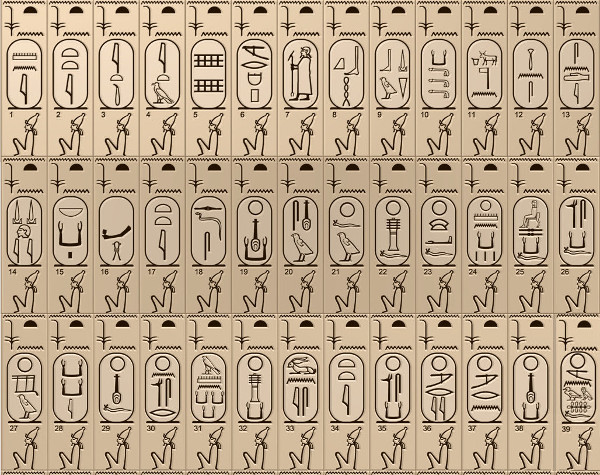 |
These cartouches form a compelling list of pharaohs. This is not a list copied down by an Egyptian scribe, which was lost, and then attempted to be restored by historians many centuries later. This list is literally "carved in stone"! There could be mistakes in the identification of which pharaohs are in which dynasties because the throne names are different from their other names, but these pharaohs and the lengths of their reigns are fairly well understood.[10] The discovery of this list was a major step forward in identifying the pharaohs of Ancient Egypt.
There is one huge problem with the chronology of Ancient Egypt as currently understood. Although the list of the pharaohs and the lengths of their reigns are known with some accuracy as shown in Table 1, that history is not anchored to any well established historical events outside of Egypt! The way that absolute dates are determined is by simply counting back from the time of Manetho all the way to the First Dynasty. The last few pharaohs he listed were the recent world rulers up through Persia and Greece, so it seemed like a good approach. But the problem is that it was the only approach which has been used for the earliest dynasties! As soon as scholars got just a few centuries back, there were no well established external historical dates for verification of the accepted chronology.
Several authors have pointed out huge discrepancies with the accepted chronology of Egypt throughout the ages. Let us consider some.
Let us review the work of four authors who have pointed out huge errors in the traditionally accepted chronology of Egypt. Each one proposes errors of several centuries. For various reasons none of them have been accepted by orthodox egyptologists.[11] Let's look at each.
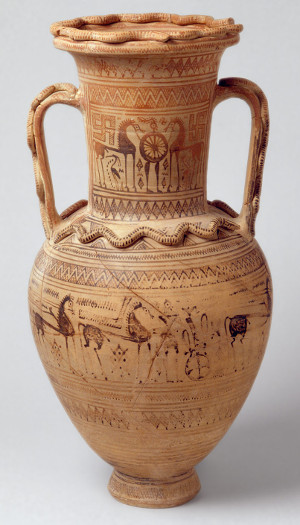 |
If, however, one just looked at the archaeological evidence in Europe, the 800 BC pottery was found in what probably should have been dated as a 500 BC layer of earth! In other words, there were no layers for 500-800 BC! Three centuries had vanished! Moreover, such early dating caused many other problems with European history which were perplexing. James shows the circular reasoning where pottery was used to date the layers and then the layers were used to date other pottery and artifacts. He showed brilliantly that all of the confusion could be eliminated by realizing that the Egyptian chronology was three centuries in error in that short period between 300 BC to 800 BC! In other words, the reigns of pharaohs believed to have been in 800 BC were really about 500 BC.
Immanuel Velikovsky wrote a three volume set of books beginning with Ages in Chaos published in 1952. He was a brilliant Jewish Russian who did detailed research into ancient records. He proposed that there is an error of many centuries in the overall traditional chronology of Egypt. For the purposes of this article, he proposed that the Old Kingdom began at least five centuries later than believed by egyptologists. He also proposed that it was the Exodus which terminated the Middle Kingdom.
His work was ridiculed and held up as an example of how even an intelligent outsider should not get involved in a discipline outside of his realm of expertise (he was a psychiatrist). Attacks were greatly bolstered because he had already been discredited by his book Worlds in Collision (1950), which suggested that renegade planets colliding caused historical catastrophes. Astronomers went berserk with outrage that anyone could propose such chaos in their nice orderly solar system!
I read those books when they came out and the attacks against him. It was interesting to me that none of the egyptologists could point to any actual proof that his discovered facts on chronology were invalid. Hence they resorted to the ad hominem attacks on the man rather than his conclusions. All of the card-carrying egyptologists were horrified that an outsider was even allowed to publish the weakness of their house of cards! His books were panned by the critics and banned from serious study. Sometimes they were marginalized to the fiction shelves of book stores!
In 1995 the book A Test of Time: The Bible From Myth to History by an agnostic new generation egyptologist David Rohl was published. In it he not only questions many of the methods and foundations of traditional Egyptian chronology, he comes up with excellent proposed solutions. His work has focused mostly on the Middle and Late Kingdoms. Like Velikovsky, he has proposed that the Exodus ended the Middle Kingdom, allowing the Asiatic Hyksos to invade, conquer, and rule Egypt for a century or so.
 |
Rohl analyzes the whole problem as an agnostic, an excellent posture for a researcher, because the atheistic bias of other egyptologists against the Bible was disastrous, yet too much belief in one's own interpretation of scripture can also lead to errors. He has truly tried to keep an open mind which must be tough because he has found so many proofs that the Bible is after all an excellent source of history and should be treated as such. The reason it must be "tough" is that he apparently believes that the army was buried in the Red Sea and that the walls of Jericho came tumbling down at the time of Joshua. But, then, Velikovsky also explained everything in terms of natural events, even as the pharaoh apparently thought that the plagues were just aberrations of nature.
There is now a growing group of "New Chronology" supporters along with David Rohl. One can easily find their books, videos and even movies on line. For the purposes of this paper, Rohl places the Exodus at the end of the Middle Kingdom. He identifies Ramses II not as the pharaoh of the Exodus, but instead as the Biblical Shishak who plundered Solomon's temple in the 5th year of Solomon's son Rehoboam (1 Kings. 14:25-26, 2 Chron. 12:1-4, 9) about 925 BC. Thus, like James, he sees about a 300-year discrepancy in the chronology of Egypt by this time, with the traditional 1200 BC really being about 900 BC.
In 1994 an LDS (Mormon) Bible-believing mining engineer dared to make a foray into the piranha-infested swamp of Egyptian chronology. His name was Jeff J. Williams and he wrote Who was the Pharaoh of the Exodus? He believed that Egypt was founded after the Great Deluge, the date of which he estimated from the Biblical account. He believed that Velikovsky had made many valid points. Moreover, he believed that the Book of Jasher was a valid historical source of dates, even though it had been rejected by scholars as a late spurious fabrication.
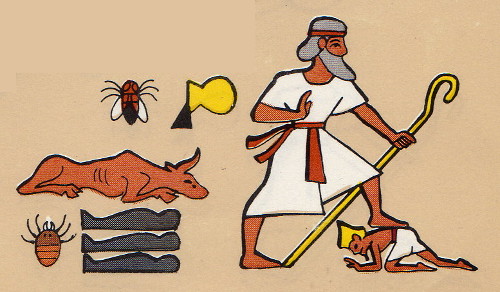 |
No one known to me took the book seriously. There was no second printing.
The next section of this article is largely a review of Williams' book because to me he had the right answer. Any astute observations about identifying the pharaoh of the Exodus are his. My contribution to his work is to offer the precise date of the Exodus which was not available to him as a needed anchor point for the chronology of the Old Kingdom.
One historically important pharaoh can be used to compare the three different chronologies. Traditional egyptologists identify Ramses II as who would have been the pharaoh of the Exodus (1250 BC) if it were not a myth. The New Chronology identifies Ramses II as having plundered Solomon's temple (925 BC), and Williams identifies Ramses II as being Necho whose army killed King Josiah of Judah (2 Chron. 35:20-24) en route to fight the battle of Carchemesh against the Babylonians (605 BC), which egyptologists interpret as the Battle of Kadesh against the Hittites. These dates illustrate that the 600-year dispute in the chronology of Egypt is not in the far distant past, but rather from 1200 BC to 600 BC. That is why this article can use the same reign lengths that egyptologists use for the first six dynasties; the mistakes occur after that time!
Let us now look at three accounts of the Exodus and see how they all seem to be telling the same story about an event of such magnitude that a world power dynasty could come to an otherwise inexplicable instant end. Could the Exodus indeed have marked the end of the Old Kingdom of Egypt?
 |
You decide. Here is a brief quote from it:
"Plague is throughout the land. Blood is everywhere... The river is blood.... Gates, columns and walls are consumed by fire.... Cattle moan ... The land is not light."[13]
Hmmm ... Let's see. How many events in history can you think of which would be described which include (1) plague being throughout the land, (2) the river being blood, (3) fire consuming everything, (4) the cattle moaning and (5) the land being in darkness? That sounds like an excellent brief description of several of the plagues! How many rivers do you know which turned to blood? To me it is amazing that traditional egyptologists are in such bondage to believing their chronology or to rejecting the Bible as to reject this obvious description of the plagues of Moses!
Williams gives the following longer summary from the papyrus which includes other important details:
There is a description of blood everywhere, and of the Nile waters being blood. References are made to hail and fire. The grain which existed yesterday is no more. The land of Egypt is not light. All of the towns have been destroyed, the royal residence has been overthrown, and the princes have been dashed against the walls. The prison has even been ruined.
There are three other points of importance found in this papyrus. The first is that there were men who rebelled against the royal symbol of authority. The second is that gold and jewels were in the possession of female slaves. The third, and last, is that the pharaoh disappeared under circumstances previously unheard of....
The papyrus also describes the condition of the country after the great destructions and the loss of the pharaoh. It tells us that anarchy prevailed. There was extensive looting and no authority existed to protect peoples' property. To make matters worse, the land was soon invaded by Asiatics whom the Egyptians were powerless to resist.[14]
Because we might have forgotten some of the details of the Biblical account, let's review them to see how closely they compare to the Ipuwer Papyrus account.
Can you name all of the plagues with which the Lord smote Egypt? See how many you can remember before we review them.
When the pharaoh wouldn't let the people of Moses go, here are the plagues which the Lord sent to help him change his mind:
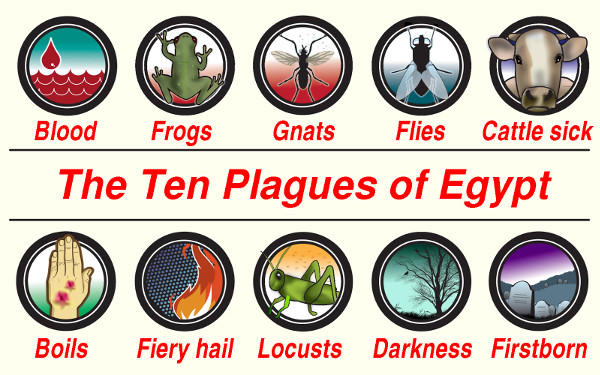 |
Ipuwer, who wrote the papyrus, scored on all of the boldface italic plagues in this list, for a score of five of the ten. He didn't mention locusts, but did say the grain all disappeared. The ones he recorded were five that the man on the street would have noticed, whereas it would not have been obvious that it was only the firstborn children who died.
Before that last plague, the Egyptians were eager to let their slaves go. At that time the Lord had Moses tell both men and women to borrow the jewelry and riches of Egypt (Exo. 11:2-3), which was also mentioned by Ipuwer.
If all of that unlikely scenario is not enough to convince the reader that Ipuwer was describing the aftermath of the Exodus, here are some more points of agreement in the two accounts.
 |
Now look at what ensues from the Egyptian perspective. None of the entire army and all others who had helped his effort by using their own horses and chariots returned! Would not that wipe out the entire government, and instantly end an orderly kingdom? It would not only leave it all open to looters as described by Ipuwer, but also, with no army, open to attack from outsiders.
On their way to the Promised Land, the Israelites soon encountered an army of the Amalekites with whom they had to go to war (Exo. 17:8). This is the famous battle during which men helped hold up the arms of Moses because when they were raised Joshua and his makeshift army prevailed (Exo. 17:11). Israel finally did win and continued on, but the Bible does not tell us what happened to the Amalekites. According to Ipuwer, they apparently invaded and temporarily conquered Egypt during what is called the First Intermediate Period!
Williams points out more evidence which points to the Exodus ending the Old Kingdom rather than the later Middle Kingdom. Memphis was the capital of the Old Kingdom, at the apex of the Nile's delta, and the land of Goshen of the Israelites was nearby on the east side of that delta. Moses often went back and forth easily between his people and the palace which strongly points to Moses having been in the Old Kingdom. After the chaotic end of the Old Kingdom, a new capital appeared far south of Goshen at Thebes in the Middle Kingdom. That would have been way too far from Goshen for Moses to have commuted so quickly (see Figure 7).
All of these arguments combine to provide compelling evidence that it was indeed the Exodus which ended the Old Kingdom.
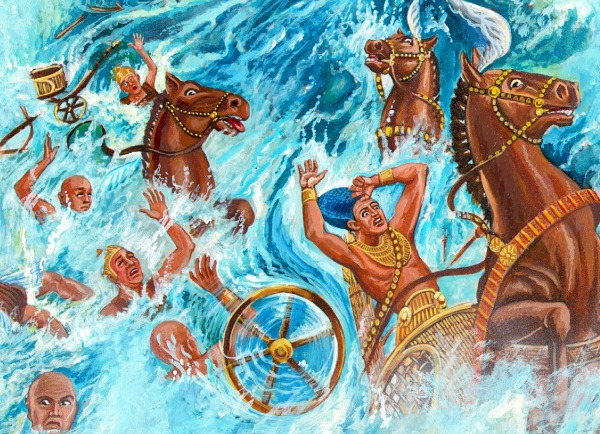 |
According to Jasher, a book written by the "Upright" rather than a single man, the pharaoh who reigned during the first 77 years of the life of Moses was named Melol. Jasher claims he had the phenomenally long reign of 94 years (Jasher 77:3). His son Adikam succeeded him at age 20 as the pharaoh. It was the latter who increased the work load of the Israelite slaves and who refused to let the people of Moses go. According to Jasher, he only reigned four years until the Exodus, whereas modern lists usually say the last pharaoh reigned one or two years. But all agree that his short reign ended in chaos.
The reign of the next to last pharaoh before the end of the Old Kingdom according to the best modern scholarship, Pepy II, lasted 94 years (as listed in footnote 10). The average length of reigns listed is about 20 years, so that one stands out as by far the longest reign of any pharaoh! He apparently began to reign at age six and lived to be 100 years old. The point here, made by Williams, is that Jasher, Africanus, and Eusebius all list his reign as 94 years! The first two are speaking of the end of the Old Kingdom, and Jasher is speaking of the Exodus, which seems compelling that all of them are speaking of the same pharaoh at the end of the Old Kingdom.
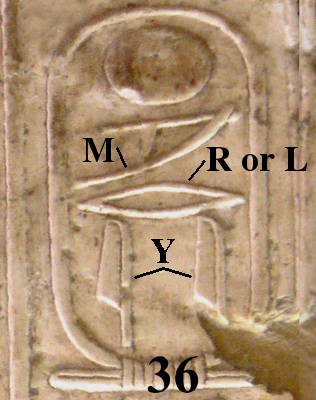 |
Moreover, egyptologists say that pharaoh #36 and #38 were both called "Pepy", that is, by the same name even though the throne name of #38 was different. Thus, it makes perfect sense that the name in the Book of Jasher for pharaoh #38 matches the throne name of #36!
The Book of Jasher even includes a pun on the name of Melol, using the L and R interchangeability. It states, "And the children of Israel called Melol the king of Egypt, 'Meror, king of Egypt,' because in his days the Egyptians had embittered their lives with all manner of work" (Jasher 65:37).
Thus, there are two huge coincidences here that to me are beyond chance. The first is that the next to last pharaoh of the Old Kingdom is listed by all as having reigned 94 years, which really ties the 38th pharaoh in the cartouches at Abydos at the end of the Old Kingdom to the pharaoh during most of the oppression of the Israelites before the Exodus! That alone could place the Exodus at the end of the Old Kingdom. Add to that the coincidence that the cartouche of the 36th pharaoh (Pepi I) could be read as Melol, the same as the name in the Book of Jasher, and that the 38th was called by the same name as the 36th (Pepy II) is compelling that the Melol of Moses was really Melol II who reigned at the end of the Old Kingdom! All of this was summarized from the research of Jeff Williams.
Also keep in mind that Jasher lists the names and lengths of reign of kings all around Israel, and often includes their descendancy. For example, just who were the Amalekites who first attacked Israel and then went on to rule Egypt in the First Intermediate Period until Egypt could recover from having lost its army? Amalek was the son of Eliphaz, son of Esau (Jasher 81:52, Gen. 36:12), the twin brother of Israel (Jacob). So far, egyptologists have identified them only as "Asiatics" which doesn't narrow it down much. Jasher is an untapped gold mine of ancient history, ignored only because scholars rejected it.
Do you believe the Bible is true? Most Christians would answer yes. Do believe that the Book of Genesis is inspired? That it is an actual well-preserved revelation to Moses? Probably also yes. But even those who answer in the affirmative to those questions may pause to consider this one: Do you believe the Genesis account of a worldwide Deluge, which covered the highest mountains and destroyed all of mankind except those on the ark?
It has been my experience that my belief in that story being true puts me in a class of "super fundamentalist" Christians. So what is it that gives me, with a PhD in astronomy, the strong belief that the Flood account is actual history? It is that within the narrative, hidden in all of its weird dates such as the exact day that the mountain tops were seen (Gen. 8:5), was discovered a chronology of the creation of the earth! The Deluge was the symbolic "rebirth" of the earth when the land first emerged from the waters (Gen. 1:9).[15] To me, only God could have hidden that secret code there, similar to Bible codes,[16] both of which are His seal of authenticity. This knowledge gives me the confidence to propose dates based on the Great Flood with a straight face, amid uproarious laughter and scoffing, trusting that later on the dates will be discovered to be correct.
For those who accept the Flood account as true, there are two obvious "bookends" consistent with the research presented so far in this article. The first is that the Bible implies that Egypt was founded after the Great Deluge. If the date of the Flood were known, it would give an absolute beginning date for Egyptian chronology. "Looking Forward" in the title of this article is not only suggesting that this work is anticipating future verification, but also suggesting that the chronology of Ancient Egypt can be found by beginning at the Deluge and reckoning forward in time.
The other excellent bookend anchor date for the end of the Old Kingdom is the date of the Exodus. Let us begin with that last proposed anchor first because it can be tied directly to the accepted king list.
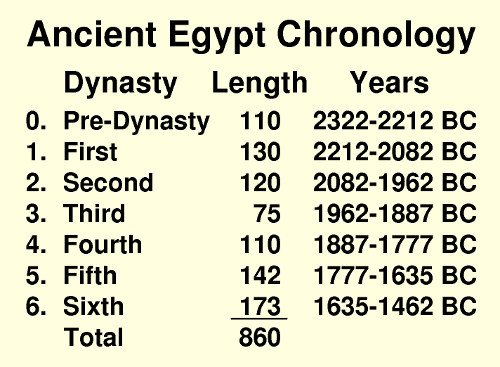 |
Let us now see what happens if we update the fairly solid dynasty list shown in Table 1 (in Section 1) by having it end in 1462 BC. Table 2 shows the results by adding historical years to the list of reigns of each dynasty.
This date is only included here because it has been a huge date for Biblical archaeologists. When it was discovered by Kathleen Kenyon from 1952-1958 that the massive walls of Jericho had indeed all fallen down[18] long ago with the top bricks found at the lowest points of what was the wall, experts were quick to point out that their precious chronology "proved" the Bible was a myth because they had fallen down around 1500 BC, long before 1250 BC to which they had dated the so-called Exodus "myth". Therefore, it was again immediately declared that the Bible was a fabrication even though the Bible itself claimed the Exodus was about 1460 BC, matching the archaeological dating!
 |
To those familiar with the law of Moses, this strange procedure, which must have caused some murmuring among the troops, symbolizes the Feast of Firstfruits which is seven weeks (cycles) of seven days after the Offering of the Omer, which in turn was symbolic of the coming Resurrection of Jesus Christ, the Firstfruits of the ground. Thus, it has been proposed in my work that the walls of Jericho fell on Firstfruits on Sun 6 Jun 1422 BC. That date is confirmed by it having been holy on many sacred calendars, being Firstfruits on four independent sacred calendars! Jericho was the first fruit plucked by conquering the cities of the Promised Land.
My proposed exact date does not add much to the discussion because New Chronology archaeologists have already determined that the walls fell in late spring after the harvest had been gathered and of course it is known from the Bible to have been forty years after the Exodus. Thus, the date is only offered here as an adjunct to the Exodus date.
There is a new line added in Table 2, not in Table 1. Just how long was the Pre-Dynastic Period before Menes united the two kingdoms of the Upper (southern) and Lower (northern) kingdoms? The Wikipedia article estimates 100 years, which seems reasonable. I chose 110 years for the following reason.
There is another implied hard minimum date for the beginning date for those that believe that the book of Genesis is a revelation and not a collection of campfire stories. Just adding up the ages given there of the antediluvian patriarchs and reckoning from 4000 BC gives a date for the Flood to have begun at about 2344 BC, with it ending a year later. In my work the exact date is clear: they exited the Ark on Sat 15 Nov 2342 BC. This date is correct whether or not one believes the Bible. It is witnessed by several sacred calendars.[19] That is, the Bible is a useful tool to discover truth, but the truth stands on its own. It just takes a lot longer to find the truth without the Bible, as demonstrated by the chronology of the egyptologists who have rejected it!
Egypt was founded after the Great Flood, not only because the earth had been washed clean of inhabitants, but because Genesis implies that the Egyptians are descendant of Ham through his son Mizraim. The Hebrew word in Genesis for "Egypt" is "Mizraim" (Gen. 10:6), implying that the bulk of Egyptians were born to Ham after the Deluge. Similarly, most countries are named after their founding father, such as Aram (Syria), Elam (Persia) and Israel (Israel). After the Flood, nations began as kindred families (Gen. 14:6). To a great extent that is still true for many of the original nations.
 |
The name Ze-ptah is interesting in itself. Ptah was one of the oldest gods of Egypt, dating back to the First Dynasty and associated with the very founding of Egypt and Memphis, its capital:
"Ptah - One of the oldest Egyptian gods who appears in the First Dynastic Period (c. 3150-2613 BCE) but most likely dates from the Predynastic Period (c. 6000-3150 BCE). Ptah was the great god of Memphis, creator of the world, lord of truth, and chief god of the city of Memphis and its surrounding area c. 3000 BCE. Ptah was originally the figure who stood on the primordial mound of the ben-ben at the creation of the world."[22]
Tradition identifies Egypt as being the center of the world where the primordial mound first rose from the primordial waters:
The primary creation myth of the Egyptians begins with the stillness of the primordial waters before the beginning of time. Out of these endless, depthless waters rose the primordial mound (the ben-ben). The pyramids of Egypt have been interpreted as representing this first hill of earth to rise from the primordial depths. Existing eternally with these silent waters (Nu) was heka - magic - personified in the god Heka who in some versions of the myth causes the ben-ben to rise.[23]
All of this sounds like Ham might have been Ptah who stood with his wife Zeptah ("Of Ptah"?) on the primordial mound which arose from the receding Flood waters after the baptism (rebirth) of the earth, symbolic of the original creation when the land emerged!
The 110-year length of the Pre-Dynasty Period Table 2 was determined as follows. The daughter of Ham and Zeptah was not on the ark when they disembarked, so she must have been born afterward. Shem's son Arphaxad was born two years after the Deluge (Gen. 11:10), so Ham and Zeptah might have had their first child also about that time. It might have taken a couple of decades for the Flood waters to recede from the lowlands of Egypt, so their daughter Egyptes, who discovered the land to become Egypt, might have been 18 years old at that time. That would put the very beginning of the Pre-Dynastic Period 20 years after 2342 BC, at 2322 BC. After all of that reasoning and estimating, my estimate only differs from the 100-year estimate on Wikipedia by 10 years!
Hopefully this article will open the door to more research into matching up Biblical and Egyptian history during this period. Precise dates for Abraham, Jacob and Joseph are given in my work. The first two of those patriarchs were forced to go to Egypt because of droughts. Perhaps those droughts can be found in Egyptian history which might help make minor adjustments to the lengths of the reigns of some of the pharaohs. The seven years of plenty and seven of famine could perhaps be recognized in Egyptian history.[24] Moreover, wars between Egypt and neighboring countries as described in the Book of Jasher, as well as the lengths of the kings of those countries, could add more enlightenment.
The current state of the art of having determined the names and lengths of reigns of the pharaohs of the first six dynasties of Egypt was reviewed and found to be satisfactory. Then the problem of those reigns never having been anchored to any known dated event in external history was reviewed. The works of four researchers were reviewed who presented evidence that the current absolute chronology of ancient Egypt appears to be too early by several centuries. The last of those proposed that the Biblical Exodus was the event which so abruptly ended the Old Kingdom at the end of the Sixth Dynasty.
Then three accounts of the Exodus were reviewed: (1) the Ipuwer Papyrus, apparently describing the plagues and disappearance of the pharaoh and government from the Egyptian point of view, (2) the Biblical account, and (3) the detail of the names of the last two pharaohs at the time of the Exodus and the lengths of their reigns in Jasher's account. The striking coincidence was noted that those quoting the lists of pharaohs and Jasher agree that reign of the penultimate pharaoh of the Old Kingdom, Pepy II, reigned for 94 years. Moreover, it was noted that pharaoh's name in Jasher (Melol) is linguistically the same as Meryre, throne name of Pepi I of the Old Kingdom. All of those points were taken to be indications that the Exodus did indeed lead to the immediate fall of the Old Kingdom.
Finally, this author's contribution to the discussion was offered, namely, the exact date of the end of the army of the pharaoh, Wed 15 Apr 1462 BC (G), the date of the closing of the Red Sea upon them. The accepted list of dynasty lengths from the first section was then anchored to end on that date and found to fit well with the account in the Book of Abraham that Egypt was founded shortly after the Great Deluge. It was then suggested that this new chronology should open the door to much future research to discover more correlations to external history and refinement of the length of the reigns of the pharaohs.
As usual in my work, again it is seen that the Bible is an accurate account of history, which can be exceedingly helpful in knowing the true history of the nations. This article is yet another witness that the Book of Genesis is indeed a revelation from God!